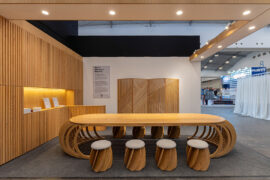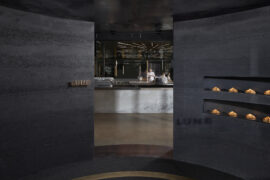It’s no secret that we love individual experiences and magical moments that can be captured and shared with friends and followers. It’s this, in part, that has begun to shape the new global phenomenon of the boutique hotel. But how can designers create a truly ‘boutique’ or ‘original’ experience when the concept is fast becoming so mainstream?
May 31st, 2017
It used to be that no matter where you landed in the world, if you stuck with the top 10 hotel chains, you could always count on ‘same service, same feeling’. It’s what the consumer demanded.
I recall seven years ago touching down in Lima, Peru, so jetlagged I could barely see straight. I bee-lined straight for the Hilton Hotel where I would be greeted by a soothingly Western reception, neatly dressed bellhops, reassuringly firm pillows, a big bathtub, slippers, and the cable television channels I liked.
In 2016, I jetsetted around the world tag-teaming between 10-or-so Airbnb homes and, no matter how jetlagged I was, it wasn’t so much the Hilton-style experience I was craving. It was that sense of living ‘truly local’.
“Today’s travellers seek a connection with local culture, community and location, so it is key for a hotel to engage with the surrounds and its people,” confirms Melissa Chen of MIKA Studios.
And we’re far more savvy when it comes to making informed choices. From Facebook – where our friends and social acquaintances live out their best and worst experiences in real time, to the rise of online travel agents with their signature scoring systems; even Google Earth allows us to preview the street frontage of our next stop-over. Very little is left to surprise.
Yet, as we become more informed our appetite for individuality grows, and with it the rise of the ‘boutique’ hotel phenomenon. The boutique hotel emerges from a blurring of boundaries. “There is no longer a clear delineation between business and leisure, meaning a guest spends more time working and relaxing in a hotels’ communal areas rather than their guest rooms,” she says. “There is [also] a narrowing of the gap between boutique and budget hotels that need to be well designed, tech savvy and provide both self-catered apartment style rooms to full service options.”
Guests look to the surrounding locale for that dose of excitement, finding comfort and familiarity in the ability to ‘adjust’ their room to just the way they like it – lighting, temperature, check-in and check-out modes, music, television and wireless technology.
A hotel’s individuality is often accentuated through location, says Rothelowman senior associate, Alicia Lynch. It’s about working with developer and client to put a hotel “in a potential place where you wouldn’t normally put a hotel”, matching the brand to the location, and offering something that’s unique to that market place.
The spirit of that hotel and its location is drawn out through unique experiences – great coffee joints in the surrounding streets, for example. Or bespoke walking tours – a trademark of The Luxury Collection. “There’s an eliteness to it, not knowing what you get until you’re exploring it, not hearing about it until someone tells you about it,” says Lynch. “It’s about providing something unique against the big buck standard.”
There’s still the demand for that big buck standard – Lynch points out Aloft Hotels and NEXT Hotels which blend boutique style hospitality with creature comforts for business travellers. But now you can get the boutique ‘detail’ and ‘character’ at a lower budget.
Clients across the board are becoming more adventurous and open to design ideas, says Chen. “They understand that good design means good business in a competitive market, with the likes of Airbnb and many larger hotel chains opening diffusion brand hotels such as Four Points, Doubletree and Canopy by Hilton, and Adagio and Mama Shelter by Accor.”
Design begins to respond to destinations, with quirky details and warmer palettes based on themes or locations. Spaces start to feel less minimal, and more eclectic and residential in character. “It is all about telling a story,” says Chen.
The challenge really comes with creating spaces that feel of the moment, of the place; quirky and character-driven, yet timeless. For all their eclectic glamour they still need to provide hard-wearing high-use longevity. Lynch holds up the Citizen M hotels by Amsterdam design studio Concrete. “My aesthetic is something that can be designed today, and built five years from now,” she says. “With simple changes not monstrous movement changes. I stayed at Citizen M four years ago and it still looks incredible today.”
Common to all these projects is the makers’ mark – a harmonious connection between architect and developer, a building of vision in unison. It confirms that design is integral to protecting boutique hotel experiences from becoming too mainstream, too quickly.
INDESIGN is on instagram
Follow @indesignlive
A searchable and comprehensive guide for specifying leading products and their suppliers
Keep up to date with the latest and greatest from our industry BFF's!

Rising above the new Sydney Metro Gadigal Station on Pitt Street, Investa’s Parkline Place is redefining the office property aesthetic.

The undeniable thread connecting Herman Miller and Knoll’s design legacies across the decades now finds its profound physical embodiment at MillerKnoll’s new Design Yard Archives.

Merging two hotel identities in one landmark development, Hotel Indigo and Holiday Inn Little Collins capture the spirit of Melbourne through Buchan’s narrative-driven design – elevated by GROHE’s signature craftsmanship.

Making a splash on the hair spa scene, the latest project from X + O makes a little slice of Japan right at home in suburban Melbourne.

The World Architecture Festival has named The Holy Redeemer Church and Community Centre of Las Chumberas in La Laguna, Spain as World Building of the Year 2025, alongside major winners in interiors, future projects and landscape.
The internet never sleeps! Here's the stuff you might have missed

Auckland Design Week returns for its third edition in March, unveiling an expanded programme and a renewed focus on the relationship between people, communities and the places they shape.

The final instalment in our three-part series on collaborations between the world’s best designers and the American Hardwood Export Council.

Cieran Murphy has been awarded The Photographer – Commercial at the INDE.Awards 2025. His work on Lune Rosebery captures the immersive design and storytelling of the space, highlighting the interplay of form, material and atmosphere in this contemporary culinary destination.